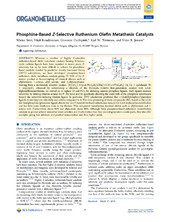Phosphine-Based Z‑Selective Ruthenium Olefin Metathesis Catalysts
Smit, Wietse; Koudriavtsev, Vitali; Occhipinti, Giovanni; Törnroos, Karl Wilhelm; Jensen, Vidar Remi
Peer reviewed, Journal article
Published version

Åpne
Permanent lenke
https://hdl.handle.net/1956/12125Utgivelsesdato
2016-05-18Metadata
Vis full innførselSamlinger
- Department of Chemistry [433]
Originalversjon
https://doi.org/10.1021/acs.organomet.6b00214Sammendrag
Whereas a number of highly Z-selective ruthenium-based olefin metathesis catalysts bearing N-heterocyclic carbene ligands have been reported in recent years, Zselectivity has so far been difficult to achieve for phosphinebased catalysts. Guided by predictive density functional theory (DFT) calculations, we have developed phosphine-based ruthenium olefin metathesis catalysts giving 70−95% of the Zisomer product in homocoupling of terminal alkenes such as allylbenzene, 1-octene, allyl acetate, and 2-allyloxyethanol. Starting from a moderately selective catalyst, [P(Cy)3](-S-2,4,6-Ph-C6H2)ClRu(==CH-o-OiPrC6H4) (4, Cy = cyclohexyl, iPr = isopropyl), obtained by substituting a chloride of the Hoveyda−Grubbs first-generation catalyst with 2,4,6- triphenylbenzenethiolate, we moved on to replace Cl and PCy3 by chelating, anionic phosphine ligands. Such ligands increase selectivity by limiting rotation around the P−Ru bond and by specifically directing the steric bulk of the phosphine substituents toward the selectivity-inducing thiolate ligand. In particular, DFT calculations predicted that o-(dialkylphosphino)phenolate ligands should improve selectivity and activity compared to 4. The most promising of these compounds (8b), based on the o-(ditert- butylphosphino)phenolate ligand, directs the two P-bonded tert-butyl substituents toward the 2,4,6-triphenylbenzenethiolate and has little steric hindrance trans to the thiolate. This compound metathesizes terminal olefins such as allylbenzene and 1- octene with Z-selectivities above 80% and allylacetate above 90%. Although these phosphine-based ruthenium monothiolate catalysts in general achieve somewhat lower activities and Z-selectivities than their second-generation counterparts, they also offer examples giving less substrate and product isomerization and thus higher yields.
